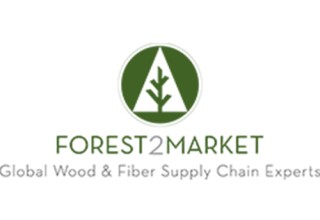Forest2Market Report Shows Changing Demand for Wood Fiber is Impacting Residuals Markets

CHARLOTTE, N.C., January 11, 2019 (Newswire.com) - As global consumer trends and demands continue to shift at an escalating pace, a new Forest2Market report shows that both structural and temporal market shifts in recent decades have impacted the markets for wood fiber residuals. The report, Changes in the Residual Wood Fiber Market 2004 to 2017, analyzes data from the U.S. Forest Service, Forest2Market’s proprietary database of timber transactions and other scientific research to understand the relationship between the supply and demand of wood residual materials over a 14-year period.
The report was commissioned by Resources for the Future (RFF), the U.S. Endowment for Forestry & Communities Inc. (Endowment) and the National Wooden Pallet & Container Association (NWPCA). The geographic scope for the study was divided into two broad regions of the United States: the U.S. South and the Pacific Northwest (PNW). Study objectives included:
- Uncovering the underlying market forces that impact the residuals market
- Assessing the nature and implications of these impacts
- Determining whether the changes occurring in the market are:
- Fundamental, structural changes that necessitate a systematic problem-solving approach, or
- Temporary, short-term, cyclical changes that require a corporate-level response
The study found that the underlying market forces that most impacted the residual market in these two regions are:
-
The structural decline in printing and writing papers and other end products derived from hardwood fiber. The hardwood pulp and lumber markets have been in a state of structural decline for years as consumer trends and preferences are moving away from products made from hardwood fiber. Demand for printing and writing papers is declining six percent annually and is expected to continue. In 2017, newsprint demand was down 10 percent from the previous year and the recent demand trends for boxboard and liquid packaging have been flat to decreasing. This has resulted in a 25 percent decrease in hardwood fiber demand in the past 10 years. In the past five years, three southern pulp mills have been converted from hardwood to pine — further evidence that hardwood pulp demand is steadily eroding. The hardwood lumber industry, hard-hit by the Great Recession, produced 30 percent less lumber in 2017 versus 2007 and residual production declined precipitously. As a consequence, Forest2Market’s report concludes that the hardwood residual market has undergone a tremendous structural shift, one the industry as a whole will have to address if it is to survive.
-
Buoyant demand for softwood fiber driven by strong pulp markets and bioenergy in the form of pellets. Demand for softwood fiber in the U.S. South has increased substantially over the last decade. The European wood pellet industry has increased demand by 10 million tons. Demand for fluff pulp for absorbent products has spawned new southern pulp production. The recovering economy along with the migration to online retailing has increased demand for cardboard boxes that are principally fulfilled by the southern pine pulp industry. Composite panel production has also increased. A concurrent increase in lumber production increased the volume of sawmill residuals available in the market. While the underlying structure of the market has certainly shifted between 2007 and 2017, the southern pine fiber and residual markets are sound and profitable.
-
Renewed softwood lumber demand and announced capacity in the U.S. South present challenges, though more for landowners than producers of residuals. While fewer pine sawmills are operating in the U.S. South over the last decade, lumber production has fully recovered to pre-recession levels. Low lumber production cost — mainly driven by very low log costs — has stimulated investment in Southern sawmills. With annual capacities of 180 to 350 million board feet (MBF) these mills will produce twice as much lumber as the mills they replaced. When they are operational, the supply of wood fiber residuals will increase between 0.32 and 0.44 million tons per year. Existing mills are also expanding as well — adding drying capacity, running longer hours and upgrading equipment to take advantage of the strong lumber market and plentiful supply of cheap softwood logs. It is most likely that the additional residuals will be quickly absorbed by the market. Growth in softwood pulp, composite panels and wood pellets will counterbalance the new supply. Pulp mills especially have flexibility in their supply chains and can easily substitute lower-cost residuals for higher-cost pulpwood. Landowners are likely to see the downside of this. Sawtimber prices have yet to reflect the uptick in lumber markets and the substitution of residuals for pulpwood will also put downward pressure on pulpwood pricing.
- Fiber constraints in the PNW that have hindered growth and led to stagnant but stable markets. The market for all products in the PNW might be best described as structurally stagnant, as the region’s limited timber availability gates the size of the market. Since pulp mills, MDF and MDP facilities are highly reliant on residuals from sawmills, the sawlog resource is the key to fiber availability. Many factors restrict sawlog availability in the PNW, the largest being the lack of harvesting on federal timberland. In order for the industry in the PNW to grow, new log resources must be supplied. This can come through improved silviculture — improving growth rates — on private timberlands, imports from other markets or increased access to timberland that has been off limits to harvesting. Without new flows for wood resources, however, the PNW will stagnate at its current size. While this could be considered a structural change from a growth perspective, the region’s industry is also reasonably healthy and profitable.
“While global markets continue to chase consumer trends, this report clearly demonstrates that rapidly changing preferences present new opportunities for an evolving forest industry,” said Pete Stewart, president and CEO of Forest2Market. “Structural changes have affected the hardwood market in the South in ways that cannot be reversed and the increased demand for softwood makes the resource-dense region a profitable destination with globally low cost structures. However, any growth opportunity in the PNW will be hamstrung due to high costs and resource constraints.”
“When one considers the nation’s majority owners of forests, private landowners, as contradictory as it might seem, keeping forests as forests is highly dependent upon robust and diverse markets,” said Endowment President and CEO Carlton Owen. “And in the case of public forests, those same markets are critical to keeping forests healthy in the face of changing climatic conditions and a tsunami of pests and diseases,” he noted.
Resources for the Future Vice President for Land, Water, and Nature Dr. Ann M. Bartuska, said, “According to the report out today, a sustainable material like hardwood fiber still faces great challenges on several important fronts in the U.S. South. For example, there has been a 25 percent decrease in hardwood fiber demand in the past 10 years and the report bluntly cautions that the industry will have to address such areas if it is to survive.” But Dr. Bartuska adds, “On the other hand, new demand for softwood fiber from the U.S. South has increased substantially, driven in part by increased demand from the European wood pellet industry. A consideration of both hardwood and softwood forest management is key to regional sustainable forestry.”
"Strong markets for products like wood chips, biofuels and sawdust allow the wood packaging sector to approach zero-waste,” said National Wooden Pallet & Container Association President and CEO Brent McClendon. “We were pleased to work with Forest2Market on this timely study as the current trends impacting hardwood and softwood residuals markets needed to be better understood.” McClendon continued, “The wood packaging industry is proud that 95 percent of all wood pallets are reused, refurbished and recycled. In addition to being used for wood pellets, mulch and paper, our industry’s environmental success story needs a full array of strong markets for wood residuals and this study provides useful information to guide future policy discussions.”
The report is available in two different formats on Forest2Market’s website: Executive Summary (eight pages) and full report (71 pages).
About Forest2Market
Forest2Market provides market pricing data, cost and performance benchmarks and analytics, as well as supply chain consulting and advisory services to customers in the forest, wood products, pulp and paper, lumber, bioenergy and biochemicals industries. www.forest2market.com
About Resources for the Future
Resources for the Future (RFF) is an independent, nonprofit research institution in Washington, D.C. Its mission is to improve environmental, energy and natural resource decisions through impartial economic research and policy engagement. RFF is committed to being the most widely trusted source of research insights and policy solutions leading to a healthy environment and a thriving economy. www.rff.org
About the U.S. Endowment for Forestry and Communities
The U.S. Endowment for Forestry and Communities (the Endowment) is a not-for-profit public charity working collaboratively with partners in the public and private sectors to advance systemic, transformative and sustainable change for the health and vitality of the nation’s working forests and forest-reliant communities. www.usendowment.org
About the National Wooden Pallet & Container Association
The National Wooden Pallet & Container Association (NWPCA) is the largest organization of wood packaging professionals in the world, with more than 670 company members in 28 countries who manufacture, repair and distribute pallets and wood packaging in unit-load solutions or who supply products and services to the industry. www.palletcentral.com
Media Contact:
Suz-Anne Kinney
Phone: +1 980 233 4021
Email: suz-anne.kinney@forest2market.com
Source: Forest2Market



